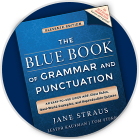|
A properly inserted semicolon helps to provide pause and clarifying separation in sentences. It also connects closely related thoughts. In this review, we'll further consider how the semicolon operates in forming lists that involve items in a series.
Semicolons Use in Lists: Items with Internal Punctuation
Some of us at some point may have come across text similar to the following:
| Marilyn continued developing a wardrobe that would complement her latest interests in style. It would feature retro silhouettes, different patterns with mixing of some, muted fall colors or blacks, whites, and reds, rich, vibrant textures, shoes with ankle straps, and definition of the waist. |
We may be able to interpret what's being written overall, but some of us may also feel as if we need to back up in some places to ensure full understanding.
Our job as writers is to convey a thought as clearly and easily as possible for our audience. The same paragraph could be made more reader friendly by separating the items into a scannable list. This is particularly true when we have internal punctuation among our items.
To do this in formal writing, we would first separate each item into lines of a list. Next, we would use a semicolon at the end of every line except for the last line to indicate the items are separated within continuing, punctuated text. We would then include the word and at the end of the second-to-last line and add a concluding period to the last line.
Because the text is continuing, we would not capitalize the first letter of each line.
Marilyn continued developing a wardrobe that would complement her latest interests in style. It would feature:
| • |
retro silhouettes; |
| • |
different patterns with mixing of some; |
| • |
muted fall colors or blacks, whites, and reds; |
| • |
rich, vibrant textures; |
| • |
shoes with ankle straps; and |
| • |
definition of the waist. |
|
Let's consider another instance in which a list with semicolons can make content more readable.
| Leticia loves to travel. Just a few of the places she has been are Madrid and Barcelona, Spain, Berlin, Frankfurt, and Munich, Germany, Rome, Naples, and Florence, Italy, Casablanca, Morocco, Nairobi, Kenya, Jerusalem and Tel Aviv, Israel, St. Petersburg, Russia, and Tokyo, Japan. |
Right away we can see this text needs semicolons to better organize all of the commas in it. An initial treatment might look like this:
| Leticia loves to travel. Just a few of the places she has been are Madrid and Barcelona, Spain; Berlin, Frankfurt, and Munich Germany; Rome, Naples, and Florence, Italy; Casablanca, Morocco; Nairobi, Kenya; Jerusalem and Tel Aviv, Israel; St. Petersburg, Russia; and Tokyo, Japan. |
The semicolons divide the items in our series more clearly. For some readers, however, the paragraph might still be an eyeful. If we wish to separate the items for easier reading within formal writing, we would once again break out the items into separate lines, end all but the last line with a semicolon, add and at the end of the second-to-last line, and conclude the last line with a period. We also would not capitalize the first letter of each line.
Leticia loves to travel. Just a few of the places she has been are:
| • |
Madrid and Barcelona, Spain; |
| • |
Berlin, Frankfurt, and Munich Germany; |
| • |
Rome, Naples, and Florence, Italy; |
| • |
Casablanca, Morocco; |
| • |
Nairobi, Kenya; |
| • |
Jerusalem and Tel Aviv, Israel; |
| • |
Petersburg, Russia; and |
| • |
Tokyo, Japan. |
|
Semicolons Use in Lists: Long or Complex Content
In some cases we may also wish to create a list with semicolons if the text is long and increasingly complex for the reader to process. This is true even if the content does not have internal punctuation.
| After examination, the association board determined that the resident had completed the right paperwork for building a shed, that the shed satisfied association requirements for external structures, that the complainant did not have proper grounds to request the shed's removal, and that the complainant's motions to the board should desist. |
Now let's break that up:
After a lengthy examination, the association board determined that the:
| • |
resident had completed the right paperwork for building a shed; |
| • |
shed satisfied association requirements for external structures; |
| • |
complainant did not have proper grounds to request the shed's removal; and |
| • |
complainant's motions to the board should desist. |
|
Note also that breaking the longer content into an itemized list with semicolons allows us to omit multiple references to the words that and the that had begun each dependent clause in the original text.
Related Topics
Semicolons
The Man Who Hated Semicolons
Connecting Sentences with Commas and Semicolons
|
View and comment on this
article on our website.
|
|
 |
The Blue Book of Grammar and Punctuation
by Lester Kaufman and Jane Straus |
Revised and Expanded Blue Book of Grammar and Punctuation Now Available!
The twelfth edition of The Blue Book of Grammar and Punctuation made its debut on May 4, 2021. It has been seven years since the eleventh edition was published. So when the publisher, Jossey-Bass, requested another go-round, the team at GrammarBook.com was elated.
You will find the new, extensively revised and expanded version in keeping with our consistent vision of a direct, concise, unfussy grammar book.
The Blue Book, which started life as a booklet for California state employees, has now sold hundreds of thousands of copies. Over the years, we’ve seen the number of subscribers to our weekly newsletter grow from dozens to scores to hundreds; now, there are over 40,000 of you worldwide.
The new edition continues to stress the difference between rules on the one hand and conventions, customs, and tendencies on the other. We also added previously uncovered material, such as irregular verbs, that have been popular topics in our newsletters and blogs. In addition, the Confusing Words and Homonyms section has been greatly expanded, and we have developed all-new quizzes covering even more topics.
The new Blue Book takes on English in all its often maddening complexity, acknowledging its quirks, gray areas, exceptions, limitations, and contradictions. We realize that people want straight answers, but with English, there sometimes aren’t any, and we would be remiss in saying otherwise.
Order your copy of the new edition of The Blue Book of Grammar and Punctuation from Amazon now!
|
Free BONUS Quiz for You!
[[firstname]], because you are a subscriber to the newsletter, you get access to one of the Subscribers-Only Quizzes. Click here to take an Advice vs. Advise Quiz and get your scores and explanations instantly!
We will be adding many more quizzes this year to our already substantial list of quizzes. If you have suggestions for topics we have not yet covered, please send us a message at help@grammarbook.com.
|
Hundreds of Additional Quizzes
at Your Fingertips
Subscribe now to receive hundreds of additional English usage quizzes not found anywhere else!
Teachers and Employers
Save hours of valuable time! You may assign quizzes to your students and employees and have their scores tallied, organized, and reported to you! Let GrammarBook.com take the hassle out of teaching English!
"Fun to test my skills."
"The explanations really help ... thanks!"
"I can select the quizzes to assign to my students, and then the results are reported to me automatically!"
99¢
QUIZZES
|
Don't need all the quizzes?
You can now purchase the same quizzes individually for ONLY 99¢ each.
Purchase yours here.
|
If you think you have found an error in a quiz, please email us at help@grammarbook.com
|
 |
The Blue Book of Grammar and Punctuation
by Jane Straus, Lester Kaufman, and Tom Stern |
The Authority on English Grammar! Eleventh Edition Also Available
An indispensable tool for busy professionals, teachers, students, homeschool families, editors, writers, and proofreaders.
Available in print AND as an e-Book! Over 2,000 copies are purchased every month!
To order the book, simply click the link to order the book from the GrammarBook.com website.
|
Wordplay

|
 |
English In A Snap:
68 One-Minute English Usage Videos FREE |
Learn all about who and whom, affect and effect, subjects and verbs, adjectives and adverbs, commas, semicolons, quotation marks, and much more by just sitting back and enjoying these easy-to-follow lessons. Tell your colleagues (and boss), children, teachers, and friends. Click here to watch.
|
|





